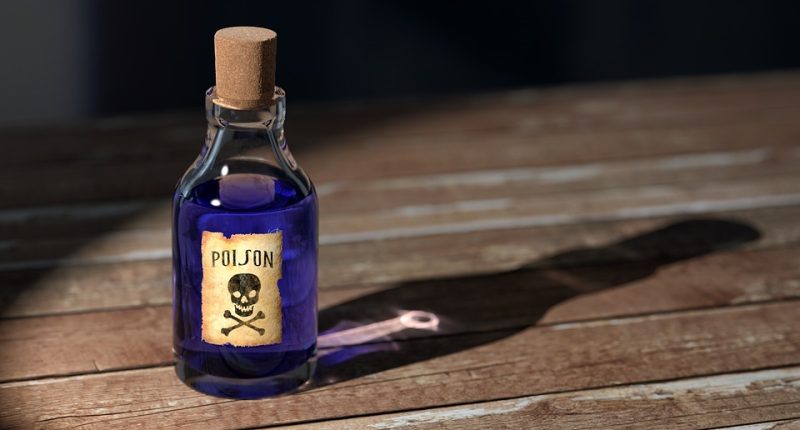Copper (tamba) as a metal is not poisonous. The physical body copper content is about 100-150 mg which is present as an integral and functional moiety of proteins and enzyme systems including catalase, cytochrome oxidase, dopamine hydroxylase and serum ceruloplasmin.
However, beacuse the body cannot synthesize copper, the human diet must supply regular amounts for absorption.
Toxic Compounds and its Uses
- Copper sulphate (Blue vitriol, bluestone, CuSO4): It occurs as large blue crystals, freely soluble in water. It may use as an agent for leather tanning and hide preservation and may be used as an emetic.
- Copper subacetate (verdigris): It occurs in a powder or in bluish-green masses of very minute crystals and is frequently used in the field of arts and external medicine.
- Copper carbonate may be a blue-green compound forming a part of the verdigris patina that’s found on weathered brass, bronze and copper. It is used as fungicide.
ACTION OF COPPER POISON
Toxicity of copper is exerted on enzymes whose activities depend upon sulfhydryl and amino groups because it’s high affinity for ligands containing nitrogen and sulfur donors (as in other heavy metals). Besides, nucleic acid can also be targets of copper toxicity.
Signs and Symptoms (Acute Poisoning)
Acute ingestion: thesecommences from 15-30 min after swallowing the poison.
System Signs and symptoms
GIT: Metallic taste, ptyalism (increased salivation), burning pain in stomach, thirst, colicky abdominal pain, nausea, eructation and repeated vomiting. The vomited matter is bluish green in colour. There is diarrhea with much straining; motions are liquid brown, rarely bloody. Renal Oliguria, hematuria, hemoglobinuria and uremia.
Hepatic Jaundice is common in severe cases. MS Cramps or spasms of legs, in some cases paralysis of limbs CNS Frontal headache, drowsiness, insensibility, irreversible coma and death may occur.
CVS: the breathing is difficult, perspiration, hypotension and symptoms of circulatory collapse.
• In severe cases, hemolysis, jaundice and hemoglobinuria are present. Individuals with G-6-phosphate deficiency could also be at increased risk of hematologic effects of copper.
• Multi-organ dysfunction syndrome may occur and death due to hepatic or kidney failure or both occurs after a couple of days.
Acute inhalation of huge doses of copper dusts or fumes can cause:
• Upper respiratory irritation leading in sore throat and cough.
• Conjunctivitis, palpebral edema and sinus irritation may also occur.
• Nasal mucousa may show atrophy with perforation.
Exposure of skin to copper compounds may cause irritant dermatitis and severe exposure may cause a greenish-blue discoloration of skin.
Fatal dose
• Copper subacetate: 15 g.
• Copper sulphate: 20 g (0.15-0.3 g/kg).
Fatal period: 18-24 h, but it’s going to reach 1-3 days.
TREATMENT
- No go to use emetics as vomiting occurs in 5-10 min after taking the poison.
- Wash out the stomach with water containing 1% solution of potassium ferrocyanide which acts as an antidote by forming insoluble cupric Ferrocyanide.
- Demulcents: Egg white or milk (form insoluble albuminate of copper) as an antidote.
- No go to use emetics as vomiting occurs in 5-10 min after taking the poison.
- Wash out the stomach with water containing 1% solution of potassium ferrocyanide which acts as an antidote by forming insoluble cupric Ferrocyanide.
- Demulcents: Egg white or milk (form insoluble albuminate ) as an antidote.
Postmortem Findings
- The skin may be yellow owing to jaundice.
- Greenish-blue froth may be present at the mouth and nostrils.
- Mucous membrane of the mouth and the content of the stomach may have bluish or greenish-blue tinge.
- Internally, some discoloration is present in the mucous membrane of the esophagus and stomach.
- Stomach: Gastric mucosa is congested, swollen, inflamed and occasionally eroded.
- Small intestine: Mucosa (upper part) shows signs of moderate irritation.
- Liver: the liver may besoft and fatty.
- Kidneys: the degenerative changes in proximal tubules may occur. Hemoglobin casts may be seen.
CHRONIC POISONING
Cause: It’s going to occurs in workers using metal and its salts due to inhalation of copper dust or fumes—welders may develop metal fume fever. It may also occur in workers with the metal from food being contaminated with verdigris from dirty copper vessels.
Signs and Symptoms
i. Green or purple line on the gums, a continuing metallic taste, nausea, dyspepsia, vomiting and diarrhea with colicky pain.
ii. Giddiness and headache.
iii. Laryngitis and bronchitis.
iv. Renal damage.
v. General signs of progressive emaciation, viz. anemia, malaise and debility.
vi. Peripheral neuritis with wrist drop or foot drop and atrophy and degeneration of muscles.
vii. The presence of copper deposits in the tissue is called CHALCOSIS. Copper may be deposited in the cornea resulting in a pigmented ring in the deeper layers.
viii. Skin becomes jaundiced. Urine and perspiration become green.
ix. Bronzed diabetes may be present.
Medico-legal Aspects
• Suicidal cases are common.
• Accidental poisoning results from eating food contaminated with verdigris which is created from action of vegetable acids on Cu cooking vessels which are not properly tinned on the inside.
• Toxicity may develop from the copper absorbed systemically from the wire utilised in certain intra-uterine contraceptive devices or from the tubing utilised in hemodialysis equipment.
• It is used rarely for homicide because of the color and taste.
• Poisoning could also be caused by ingestion of food to which copper has been added to keep the color of vegetables green.
• Children sometimes swallow coppersulphate (CuSO4) crystals attracted by its color.
• Rarely, it’s used as cattle poison.
• Copper sulphate was used as an antidote in case of phosphorus poisoning and in wound debridement.
For more metallic poison, check out the link.








